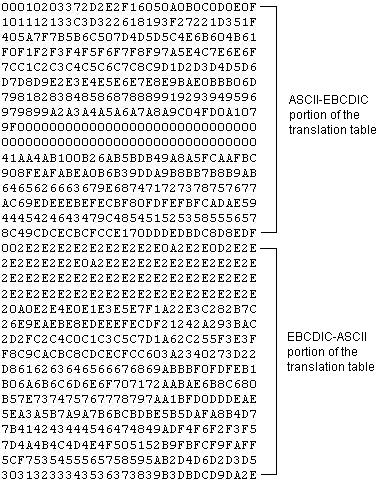Conversion Tables/Custom Code Conversion
With this feature, you can convert text files between various character-set specifications.
1. Convert the file using the iconv utility, then send the file as a binary file.
2. Send a file to Platform Server for z/OS, then use Platform Server for z/OS to perform double byte conversion. For more information on double byte conversion, see LCT and RCT parameters in the TIBCO Managed File Transfer Platform Server for z/OS User's Guide.
The Platform Server provides the following four conversion tables:
| Conversion Table | Description |
|---|---|
| Comtblg.classic | The old comtblg.dat shipped with previous versions (before version 7.1). |
| Comtblg.cp037 | Extended ASCII table that is based on IBM Code page 037. |
| Comtblg.cp1047 | Extended ASCII table that is based on IBM Code page 1047. |
| Comtblg.dat | ASCII/EBCIDIC table used by the platform server at run time. (By default a copy of Comtblg.cp037.) |
To activate conversion tables, you have to turn the ASCII_to_EBCDIC parameter on. For more information, see ASCII_to_EBCDIC parameter in Optional Transfer Properties.
When this parameter is on, it uses the file names that are specified in the ConvTbl, LocalCTFile, and RemoteCTFile parameters. For more information, see CONVTBL, LocalCTFile and RemoteCTFile in Optional Transfer Parameters.
You can define the ConvTbl parameter in the config.txt file to specify the default conversion table for all transfers. If this parameter is not set, the $CFROOT/Comtblg.dat file is used.
The first 16 lines in this file are used when sending data to a partner, that is, converting ASCII data to EBCDIC. The last 16 lines are used when receiving data from a partner, that is, converting EBCDIC to ASCII. ASCII to EBCDIC translation is typically performed on the ASCII systems (Windows and UNIX) and not on the EBCDIC systems (z/OS and IBM i). You can specify two conversion tables: one on the local side (LCT), and one on the remote side (RCT). If you want to perform translation on one side of the transfer and not on the other side, specify a translation table of None.
Example: LCT:CustomTable RCT:None or LCT:None RCT:CustomTable
You can define the local conversion table using the LocalCTFile parameter in a transfer template or the lct parameter on the command line. Similarly, you can define the remote conversion table using the RemoteCTFile parameter in a transfer template or the rct parameter on the command line. The maximum lengths of the lct and rct parameters are both 16 characters. However, they support file names relative to the current working directory and the $CFROOT directory.
- For UNIX, the directories are searched in the following order: the directory where CyberResp is running, the $CFROOT environment variable if it is defined in the environment of the CyberResp process, and then in the /mftps directory.
- For z/OS, the platform server searches an in-core table that has to be enabled at startup or through an operator command.
- For Windows, the platform server searches in the MFT Platform Server working directory.
For a File Send, the top 16 lines of the conversion table is used for ASCII to EBCDIC conversion. For a File Receive, the bottom 16 lines of the conversion table is used for EBCDIC to ASCII conversion. For example, in a send transfer, if both the LocalCTFile and RemoteCTFile parameters are used, then the top half of local conversion table file is used on the local side, and the bottom half of remote conversion table file is used on the remote side. The reverse is true for a receive transfer.
Nodes also support both local and remote conversion tables. Unless the parameters are overridden on the command line, conversion tables are used whenever that node is specified.
